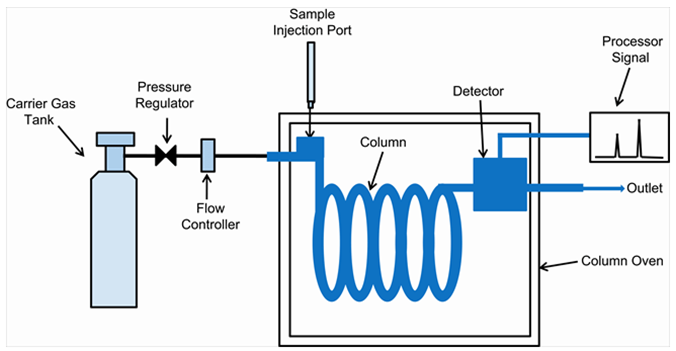Principle of Gas Chromatograph
Chromatography is a physical separation technique. The principle of separation is to distribute the components of the mixture between two phases, one of which is immobile and is called the stationary phase; the other phase is the fluid that drives the mixture to flow through this stationary phase and is called the mobile phase. When the mixture contained in the mobile phase passes through the stationary phase, it interacts with the stationary phase. Due to the differences in the nature and structure of the components, the strength of the interaction varies in size.
Therefore, under the same driving force, the retention time of different components in the stationary phase is longer or shorter, so that they flow out from the stationary phase in sequential order. This technique of obtaining separation of components in a mixture by the principle of two-phase partition is called chromatographic separation technique.
In gas chromatography (GC), the mobile phase is a gas and the stationary phase can be a solid (solid-liquid GC) or an immobile liquid high polymer (liquid-gas GC). Of these two types of GC, liquid-gas GC is far more commonly used than solid-gas GC.
In GC, separation of analytes is achieved by exploiting their different affinities for stationary phases and by adjusting their relative vapor pressures. In practice, this process is achieved by selecting stationary phases with different chemical properties and adjusting the column temperature.
 Schematic diagram of the main components of a gas chromatography system (Philadelphia College of Pharmacy, 2012)
Schematic diagram of the main components of a gas chromatography system (Philadelphia College of Pharmacy, 2012)
Structure of the Gas Chromatograph
1. Carrier gas system: including gas source, gas purification, gas flow rate control and measurement
2. Injection system: including injector, vaporization chamber (instantaneous vaporization of liquid samples into vapor)
① Manual microsampler: It can extract gas or liquid samples, and is suitable for gas chromatographs with manual injection.
② Solid-phase microextraction injector: It can be used to extract organic matter in liquid or gas matrix. The extracted sample can be injected directly into the vaporization chamber of the gas chromatograph for thermal resolution and vaporization, and then into the column for analysis. This technology is suitable for the analysis of organic matter in water or some volatile components in other samples.
③ Liquid autosampler: It can realize automatic operation, reduce human injection errors and manual operation costs, and is suitable for the analysis of batch samples.
④ Valve injection system.
a. Gas injection valve: Gas samples are injected by valve, which not only has good quantitative repeatability, but also can be isolated from the ambient air to avoid the contamination of air on the samples. It can also be combined with multiple columns and valves, which can perform some special analysis.
b. Liquid injection valve: generally used for on-line sampling and analysis of liquid samples.
⑤ Blowdown trapping system: used for enrichment of volatile organic compounds in solid, semi-solid and liquid sample matrices and direct access to the gas chromatograph for analysis.
⑥ Thermal desorption system: used for the trapping of volatile organic compounds in gas samples and then thermal desorption into the gas chromatograph for analysis.
⑦ Headspace injection system: headspace injector is mainly used for the analysis of volatile organic compounds in solid, semi-solid and liquid sample matrix.
⑧ Thermal cracker injection system: theoretically, it can be applied to any organic compounds that cannot be separated and analyzed yet by gas chromatograph due to poor volatility, but currently it is mainly used for the analysis of polymers.
⑨ Cold on-column injection system: The sample is injected at room temperature or lower. The sample components are then vaporized by programmed warming and successively enter the column for separation. This injection method is suitable for the analysis of thermally unstable sample components, and can also be used for high-precision analysis of trace components.
3. Chromatographic column and column temperature: including thermostat control device
4. Detection system: including the detector, temperature control device. The following detectors are commonly used:
① Thermal conductivity detector (TCD)
TCD is a concentration-based detector, i.e., the response value of the detector is proportional to the concentration of the component in the carrier gas. Its basic principle is based on the fact that different substances have different thermal conductivity coefficients and respond to almost all substances, making it the most widely used general-purpose detector.
Since the sample is not destroyed during the detection process, it can be used for preparation and other coupled identification techniques.
② Hydrogen flame ionization detector (FID)
The FID uses the chemical ionization of organic substances in the presence of a hydrogen flame to form a stream of ions, which is detected by measuring the intensity of the stream. This detector is commonly used for the detection of organic compounds because of its high sensitivity, wide linear range, undemanding operating conditions, low noise, and small dead volume.
However, the sample is destroyed during detection, and generally only those organic compounds that burn in the hydrogen flame to produce a large number of positive carbon ions can be detected.
 The flame ionisation detector (FID) (From LibreTexts libraries)
The flame ionisation detector (FID) (From LibreTexts libraries)
③ Electron capture detector (ECD)
ECD uses the ability of electronegative substances to capture electrons and detects them by measuring electron flow. ECD is characterized by high sensitivity and good selectivity.
It is an exclusive type detector and is currently the most effective detector for the analysis of trace electronegative organic compounds. The stronger the electronegativity of the element, the higher the detector sensitivity. It has a high response for compounds containing halogens, sulfur, oxygen, carbonyl, amino, etc.
It can be used as a carrier gas of nitrogen or argon, the most commonly used is high purity nitrogen.
④ Flame photometric detector (FPD)
FPD has a relatively high sensitivity and selectivity for compounds containing sulfur and phosphorus. The detection principle is that when phosphorus- and sulfur-containing substances burn in a hydrogen-rich flame, they emit spectra with characteristics, respectively, through an interference filter, and the intensity of the characteristic light is measured with a photomultiplier tube.
5. Recording systems: including amplifiers, recorders, or data processing devices, workstations
Workflow of Gas Chromatograph
- The inert carrier gas (helium) is introduced into the GC instrument from a storage tank, the pressure of which can be adjusted manually or by an electropneumatic controller.
- The regulated carrier gas flows from the inlet through the capillary tube and eventually reaches the detector.
- The sample is injected into the inlet, heated and volatilized, and carried by the carrier gas into the capillary GC column.
- The sample is separated in the capillary gas chromatography column. The components of the sample are finally separated due to their different relative vapor pressure and solubility in the liquid stationary phase, resulting in their different partitioning in the mobile and stationary phases.
- The sample components (analytes) flow out of the capillary with the carrier gas and enter the detector at the same time. Based on the physicochemical properties of the analyte, the detector generates a response that is eventually converted into an electrical signal to measure the amount of analyte.
- The data processing system generates an integrated chromatogram.
Modern GC technology allows the analysis of samples in a wide range of media including solids, liquids and gases. GC columns with special design can withstand high temperatures, thus making it possible to analyze relatively difficult to volatilize substances. Column head cooling injection technology solves the problem of feeding thermally unstable substances.
Creative Proteomics offers metabolomics services in a wide range of applications based on gas chromatography technology. If you would like more detailed information, please feel free to contact us.
For Research Use Only. Not for use in diagnostic procedures.


 Schematic diagram of the main components of a gas chromatography system (Philadelphia College of Pharmacy, 2012)
Schematic diagram of the main components of a gas chromatography system (Philadelphia College of Pharmacy, 2012) The flame ionisation detector (FID) (From LibreTexts libraries)
The flame ionisation detector (FID) (From LibreTexts libraries)
